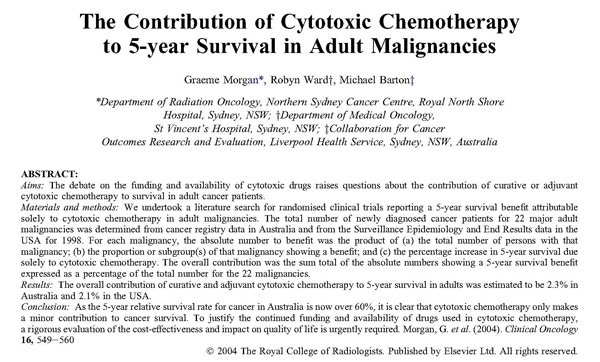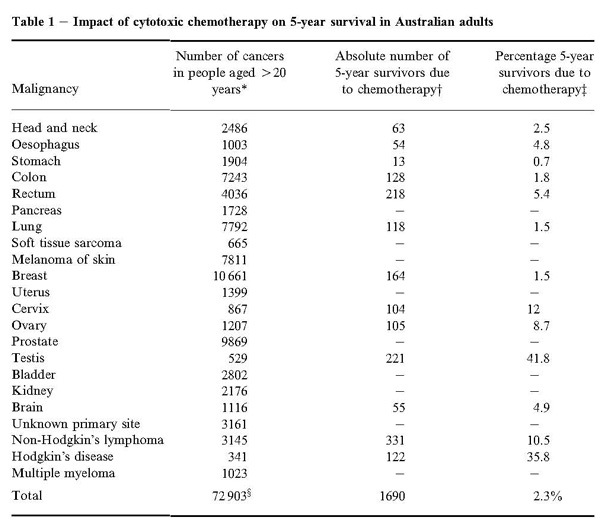The Story of Avastin That You Need to Know
On February 26, 2004, the FDA approved Avastin (or bevacizumab) as a first-line treatment for patients with metastatic colorectal cancer, i.e., cancer that has spread to other parts of the body. Avastin was shown to extend patients’ lives by about five months when given as a combination treatment along with standard chemotherapy drugs for colon cancer (the “Saltz regimen” also known as IFL). IFL treatment includes ironotecan, 5-fluorouracil (5FU) and leucovorin.
Source: http://www.cancer.gov/cancertopics/druginfo/fda-bevacizumab#Anchor-Approva-23287
Take note of this fact carefully and serious ly – nowhere in the medical literature does it say Avastin cures cancer. It does not. When given with IFL, Avastin made patients lived longer by about five months. That was all. And the average time before tumors started regrowing or new tumors appeared was four months longer than patients receiving IFL alone.
Avastin Approved As Second-Line Treatment of Metastatic Colorectal Cancer
On June 20, 2006, the FDA granted approval for Avastin for use as second-line treatment of metastatic carcinoma of the colon or rectum. This recommendation is based on the demonstration of improvement in overall survival (OS) of patients receiving Avastin plus FOLFOX4 (5-flourouracil, leucovorin, and oxaliplatin) when compared to those receiving FOLFOX4 alone.
Mean overall survival of patients receiving Avastin + FOLFOX4 was 13.0 months while those receiving FOLFOX4 alone was 10.8 months.
Source: Source: http://www.cancer.gov/cancertopics/druginfo/fda-bevacizumab#Anchor-Approva-51277
Take note again. Patients receiving Avastin + FOLFOX4 lived longer by only 2.2 months. Avastin did not cure. It only extended life by 2.2 months. Is that what patients want? Do oncologists clearly tell this fact to patients before they give them Avastin?
Each Avastin injection cost a lot of money. It is NOT cheap for most people. Money is one point, Avastin comes with a bunch of devastating side effects. The most serious, and sometimes fatal side effects of Avastin are:
- gastrointestinal perforation,
- wound healing complications,
- hemorrhage,
- thromboembolic events,
- hypertensive crisis,
- nephrotic syndrome and
- congestive heart failure.
The most common adverse events in patients receiving Avastin are: asthenia (fatigue or weakness), pain, abdominal pain, headache, hypertension, diarrhea, nausea, vomiting, anorexia, stomatitis, constipation, upper respiratory infection, epistaxis (nose bleed), dyspnea (shortness of breath –SOB), exfoliative dermatitis and proteinuria (excess proteins in the urine). Source: http://www.avastin.com/avastin/patient/crc/index.html#/crc/treatment/
Avastin for Colon Cancer – Any good?
A posting on 19 September 2010 has this heading: Second Avastin Trial Shows No Benefit in Early Stage Colon Cancer. Adding Avastin to chemotherapy for early stage colon cancer didn’t reduce the risk that cancer would return. Source: http://fightcolorectalcancer.org/research_news/2010/09/second_avastin_trial_shows
A statement released by the drug company, Roche of Switzerland (http://www.roche.com/investors/ir_update/inv-update-2010-09-18b.htm) stated that:
- A study known as AVANT evaluated the use of Avastin plus chemotherapy in the adjuvant treatment (immediately after surgery) of early-stage colon cancer. The results did not show that it improved disease-free survival in stage III colon cancer.
- Evaluation of Avastin in the early-stage setting, the AVANT study shows that standard chemotherapy plus one year of Avastin is NOT effective in reducing the risk of relapses in early-stage colon cancer.
In another posting on 25 Janruary2011,entitled: AVANT Says No Avastin Benefit in Stage III Colon Cancer
Source: http://fightcolorectalcancer.org/research_news/2011/01/avant_says_no_avastin_benefit_in_stage_iii_colon_cancer
A second randomized clinical trial has confirmed what the first one found — adding Avastin to standard chemotherapy does not reduce recurrences after surgery for stage III colon cancer. In presenting the trial results at the 2011 GI Symposium, Aimery De Gramont, MD, PhD, concluded:
- The addition of Avastin to FOLFOX4 or XELOX did not improve disease-free survival (DFS) in the adjuvant treatment of Stage III colon cancer.
- Immature overall survival data suggest a potential detriment.
- In the first year, there was a transient favorable effect.
- The treatment effect became unfavorable after one year.
What the Mass Media Said
Avastin Falls Short in Test as Colon Cancer Medicine. Source: http://www.nytimes.com/2009/04/23/health/23avastin.html
Andrew Pollack of the New York Times, wrote on 22 April 2009: In results from a widely watched clinical trial, the drug Avastin failed to show a significant effect on preventing the recurrence of colon cancer. Avastin had sales of $2.7 billion in the United States alone last year.
Melly Alazrakip of Daily Finance wrote: Roche’s Avastin Fails in Early-Stage Colon Cancer Study
Source: http://www.dailyfinance.com/2010/09/20/avastin-cancer-drug-roche-fails-colon-study/
The top-selling cancer-fighting drug Avastin, which was once believed to have the potential to help treat many cancers, has hit another roadblock in testing. In a recent Phase III study, Avastin failed to improve disease-free survival in early-stage colon cancer patients when administered immediately after surgery.
Roche, the world’s largest maker of cancer drugs, said data from the study showed that adding Avastin to standard chemotherapy for one year after surgery wasn’t effective in reducing the risk of relapses. Indeed, the data showed better outcomes for standard chemotherapy alone.
As the world’s best-selling cancer drug, Avastin recorded nearly $6 billion in sales last year.
Avastin has experienced other setbacks this year, including Great Britain again refusing to approve Avastin for colorectal cancer on the basis of its poor cost-effectiveness, and another late-stage study showing Avastin failed to extend survival in men with advanced prostate cancer, compared to current treatments.
Take note here: Avastin is not allowed in Great Britain on the basis of poor cost-effectiveness.
In the poor developing countries, Avastin can be used? Is that logical?
Avastin for Other Cancers
In spite of its poor performance, Avastin had and is being used rather commonly for the following cancers:
- Metastatic Renal Cell Carcinoma (mRCC)
Avastin is indicated for the treatment of metastatic renal cell carcinoma in combination with interferon alfa. - Non–Squamous Non–Small Cell Lung Cancer (NSCLC)
Avastin is indicated for the first-line treatment of unresectable, locally advanced, recurrent or metastatic non–squamous non–small cell lung cancer in combination with carboplatin and paclitaxel. - Brain cancer.
- Just not too long ago, Avastin was also approved for the treatment of breast cancer.
Castle Built On Sand – Avastin for Breast Cancer
Andrew Pollack of the New York Times (23 February 2008,http://www.nytimes.com/2008/02/23/business/23drug.html)
reported that the FDA approved Avastin as a treatment for breast cancer – a decision that appeared rather baffling to the common mind. But as always, we know that a FDA approval means an additional hundreds of millions of dollars of annual sales to Avastin.
As a breast cancer treatment, Avastin costs about UD$7,700 a month, or US$92,000 a year.
Let us look at the results of the clinical trial on which the approval was based.
- Women who received Avastin in combination with the chemo-drug Taxol (or paclitaxel) had a median of 11.3 months before their cancer worsened or they died, in contrast women who received Taxol alone had a median of 5.8 months. This means Avastin only delayed cancer worsening by 5.5 months.
- Women who received Avastin lived a median of 26.5 months, compared with 24.8 months for those getting Taxol alone — life extension that was not statistically significant. This means Avastin prolonged life by 1.7 months which is meaningless and this difference could just be due to chance and not real.
- Moreover, the women receiving Avastin suffered more side effects. And 5 or 6 of them out of 363 died from the drug itself.
In spite of such miserable performance, Avastin was approved for breast cancer treatment. And many patients in this part of the world, including Malaysia, were given Avastin by their oncologists.
A castle built on sand would not last!
Matthew Perone of the Associated Press, on 15 December 2010 wrote: http://www.msnbc.msn.com/id/40702735/ns/health-cancer/t/avastin-shouldnt-be-used-breast-cancer-fda-says/
Federal health authorities recommended Thursday that the blockbuster drug Avastin no longer be used to treat breast cancer, saying recent studies failed to show the drug’s original promise to help slow the disease and extend patients’ lives.
The ruling is a significant setback for the world’s best-selling cancer drug and will likely cost Swiss drugmaker Roche hundreds of millions of dollars in lost revenue.
The FDA approved Avastin for breast cancer in 2008 based on one study suggesting it halted the spread of breast cancer for more than five months when combined with chemotherapy. But follow-up studies showed that the delay lasted no more than three months, and patients suffered dangerous side effects.
Roche sells the drug at a wholesale price of $7,700 a month. When infusion charges are included, a year’s treatment with Avastin can run to more than $100,000.
Comment
Avastin – it is all about big money but the results of Avastin are just miserable. It falls far short of the patients’ expectation. They expect the chemo drug to cure their cancers or at least prolong their lives for many more years! The truth is, Avastin does not and cannot do that!







You must be logged in to post a comment.